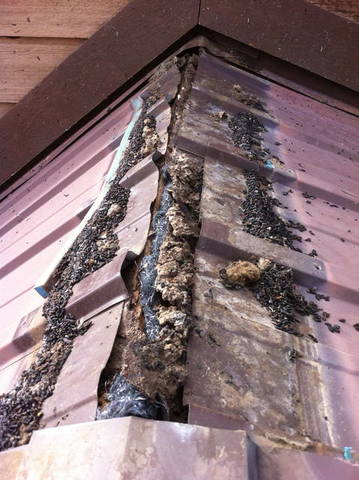When you have a steel roof with the openings at the guttter and fascia line, do you close them off. Also do they serve any kind of purpose for air flow. If you do seal them off do you just foam them shut.
I have a lot of "pro panel" and other metal roofing systems out here along with the old traditional corrugated roofing that is just basic fare.
I've seen where companies who I won't name have told the customer all of these points must be sealed and they made lots of money doing it.
When I first starting looking and beginning bat work this made sense to me until I ended up looking beneath the metal and realized that largely this was unnecessary.
In my state that roofing is typically laid over exterior osb board that is fitted tightly over the bulk of the roof. In other words, if the bats crawl up the channel, they are locked in the channel until they get to the possible opening at the ridge vent area. In most cases this means a 20+ foot crawl through this little space (which is possible), that is often not the norm.
The rubber or foam inserts in my state due to high winds are often gone or missing in part both at the area you are worried about and at the ridge vent area.
So where do I see bat entry points with metal roofing of this type?
1) check the ridge vent for signs of entry, often there isn't any sign on mine but when you unscrew the metal ridge and look under it guano, urine and dead bats abound.
2) check the drip edge flashing, which makes a great day roost location by itself and isn't really a problem unless when they crawl in under there they find a spot where the sheeting isn't tight (which is common!) and enter the attic or wall void.
3) If you can get inside the attic if the building has one this can tell you many things you may not be able to clearly see from outside.
It really comes down to how the building is built which of course for bats and other wildlife is really the confounding thing sometimes because even with building codes lots of literal corners are cut and these are what we are looking for to resolve the issues.
Now that I've had a bunch of metal roofs I've learned a ton but I'm still learning about little things each day that help make me better at my job and save me time and money as well.
In my state those rubber or foam inserts are usually set back about 12 inches or so, which makes a flashlight inspection up into the crack the way to go to know if the bats can continue on their climb.
I look at the ridge vent as the main culprit along with the edges where flashing is almost never perfect.
Also depends on whether the client wants bat damage solved (guano, urine, large colony in attic) or if they don't want any bats in their roof anywhere.
Many single bats even in NM where our temps are way over 100 for many months use these corrugated spaces as day roosts.
I'm not a roofer but obviously air flow and the problems caused by blocking it are always a concern to keep yourself from causing damage in the future to the proper construction and use of those gaps.
I've seen tons of them now where someone foamed them all in with pur only to have the general contractor hired for some other siding repairs and such rip it all out and complain to the owner that the "critter guy" didn't know what he was doing, so for my .02 make sure what you do not only solves the bat issue but doesn't get you into a bind legally or reputation wise.
When in doubt I ask someone local who installs roofing, siding, etc.....and is licensed and in good standing. My reputation and my budget is not something I care to gamble with.
Good luck, interested to hear what you find. I've got pics of some of the spots I see them if it would help as I'm sure others do as well who have many more years experience than I do.
Justin
Here is one pic, the xcluder fabric you see was placed just for the morning and was removed following screening of this access point. So if you look at this pic and can imagine the bats entering down at the bottom where you are concerned and crawling up to the top they can then drop in the attic or live in the ridge vent area if heat and conditions are right. These attics had no blocker whatsoever so bats were entering under the ridge vent and dropping by the dozens into the attic space.







